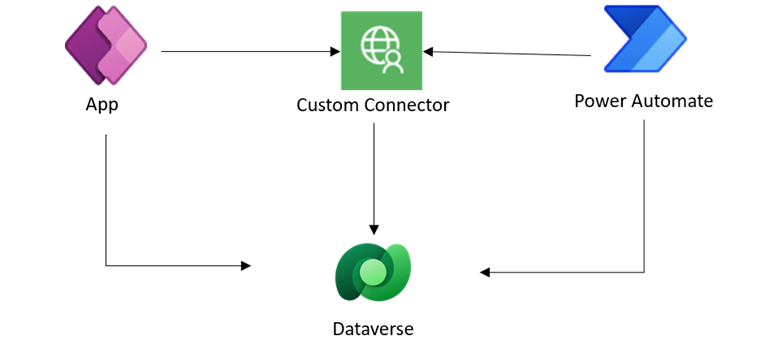Table of Contents

At HelloX Tech Ltd., we often work with organizations who are new to Microsoft Dataverse and Power Automate, and are exploring how to connect their existing systems to the Microsoft ecosystem. Whether you’re using in-house databases, legacy applications, or third-party cloud services, this article gives you a high-level overview of what’s possible—and how it can bring immediate value to your operations.
Below, we break down the essentials of Dataverse, Power Automate, and how integration works via APIs and custom connectors.
1. 🧩 Microsoft Dataverse Web API
The Dataverse Web API is a RESTful service that allows external systems to securely access and manipulate Dataverse data using standard HTTP protocols.
With the Web API, your systems can:
-
- Read or write data from/to Dataverse
-
- Trigger business logic
-
- Run queries and fetch related records
-
- Perform operations similar to SQL (using OData syntax)
This is ideal for advanced integrations where direct, real-time communication with Dataverse is required.
➡️ Use the Microsoft Dataverse Web API
➡️ Full API Reference
2. ⚙️ Power Automate
What is Power Automate?
Power Automate is Microsoft’s cloud-based automation platform that enables you to automate workflows across Microsoft 365 and hundreds of other applications without writing code.
You can use Power Automate to:
-
- Automate repetitive tasks like sending emails or syncing data
-
- Set up approval workflows (e.g., leave requests or budget sign-offs)
-
- Trigger processes when records are created or updated in systems
-
- Schedule jobs or run flows based on conditions (e.g., only on weekdays)
This tool is perfect for both business users and developers. It speeds up your processes, reduces manual effort, and increases accuracy.
➡️ Explore Power Automate (official site)
Out-of-the-box connectors for third-party systems
Power Automate includes hundreds of pre-built connectors to widely used platforms such as:
-
- Salesforce
-
- SharePoint
-
- Dropbox
-
- SQL Server
-
- SAP
-
- Google Drive
-
- Outlook
-
- Adobe PDF Services, and more
These out-of-the-box (OOB) connectors allow you to automate tasks across multiple apps with minimal setup—no need to build custom code for every connection.
➡️ See the full list of connectors
Create Custom Connectors in Power Automate
If the system you’re working with doesn’t have a pre-built connector, Power Automate allows you to build a custom connector. These connectors are wrappers around any REST API you provide, giving your organization the flexibility to integrate nearly any web-based application into your flows.
You can define:
-
- Authentication methods (OAuth2, API keys, etc.)
-
- Request parameters and response handling
-
- Actions and triggers that will be available inside Power Automate
➡️ Custom connectors overview
➡️ Create a custom connector from scratch
3. 🗃️ Microsoft Dataverse
What is Dataverse—and why is it special?
Microsoft Dataverse is the secure, scalable data platform behind many Microsoft Power Platform applications (like Power Apps and Power Automate). Think of it as a cloud database built for business apps, complete with relational data modeling, field validation, role-based access, and auditing.
Key benefits:
-
- Deep integration with Microsoft 365 and Dynamics 365
-
- Tables, relationships, calculated fields, file storage
-
- Supports plug-ins, business rules, and automated flows
-
- Designed for both citizen developers and professional developers
If you’re building internal tools or portals that need structured, secure, and scalable data storage, Dataverse is the platform to explore.
➡️ What is Microsoft Dataverse?
Role-based security controls
Dataverse includes a robust security model that ensures data is only accessible to the right people. You can configure:
-
- Security roles: Define who can create, read, update, or delete records
-
- Team-based access: Share permissions across functional groups
-
- Row-level and field-level security: Hide sensitive data from unauthorized users
-
- Environment-level isolation: Control access across development, test, and production environments
This makes Dataverse a good fit for organizations with privacy, compliance, or internal governance requirements.
➡️ Dataverse Security Roles & Privileges
👋 Final Thoughts
Even if your organization is just starting with Microsoft’s Power Platform, these tools are powerful enablers of digital transformation. You don’t need to overhaul your existing systems—just connect them using APIs, Power Automate, or custom connectors and let Dataverse manage your data with enterprise-grade control.
If you’d like help setting up your first flow or exploring integration options, feel free to contact us at HelloX Tech Ltd. We’re happy to help!
